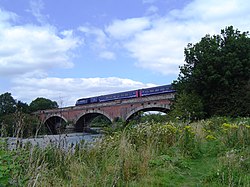Moulsford Railway Bridge
Moulsford Railway Bridge | |
|---|---|
 Moulsford Railway Bridge (original) from downstream | |
| Coordinates | 51°33′29″N 1°08′33″W / 51.55806°N 1.14250°W |
| Carries | Great Western Main Line |
| Crosses | River Thames |
| Locale | Moulsford |
| Maintained by | Network Rail |
| Heritage status | Grade II* listed |
| Characteristics | |
| Design | Skew arch |
| Material | Brick |
| Height | 21 feet 8 inches (6.60 m)[1] |
| No. of spans | 4 |
| Piers in water | 3 |
| History | |
| Designer | Isambard Kingdom Brunel |
| Opened | 1839 and 1892 |
| Location | |
 | |
Moulsford Railway Bridge, known locally as "Four Arches" bridge[2] is a pair of parallel bridges located a little to the north of Moulsford and South Stoke in Oxfordshire, UK. It carries the Great Western Main Line from Paddington, London to Wales and the West across the River Thames. It lies between the stations at Goring & Streatley and Cholsey, and crosses the Thames at an oblique angle on the reach between Cleeve Lock and Benson Lock. It is a Grade II* listed structure.[3]
Construction
First bridge
The original bridge was designed to carry two broad gauge tracks by Isambard Kingdom Brunel for the Great Western Railway and was built between 1838 and 1839, at the same time as Maidenhead and Gatehampton railway bridges. It is constructed from red brick with Bath stone quoins as four elliptical skew arches of 62 feet (19 m) span and a headway height of 21 feet 8 inches (6.60 m).
Second bridge
In 1892 the line was converted to quadruple track and a second bridge was built alongside the upstream side of the original and connected to it by girders and brick bridgelets. The second bridge was built to the same profile and dimensions as the original but it lacks the stone quoins of the original and the plain uncut bricks make a jagged pattern where they meet the faces of the bridge. The second bridge is also narrower, having been built to carry a pair of standard gauge tracks.
Picture gallery


See also
References
- ^ River Thames Alliance. Bridge heights on the River Thames.[permanent dead link]
- ^ "The Cholsey Parish Plan" (PDF). Cholsey Parish Council. 2006. Retrieved 28 December 2009.[permanent dead link]
- ^ Historic England. "Moulsford Viaduct (MLN14730) (1285970)". National Heritage List for England. Retrieved 9 April 2016.
